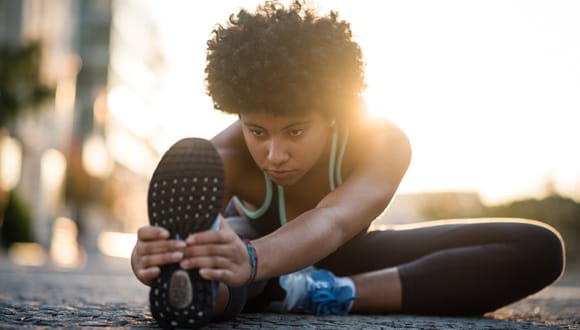The stronger your leg muscles are, the more they can help cushion your knee joint during impact or exercise. It's why you hit the squat rack on leg day or lunge across your bedroom as part of your at-home workout.
But, there's another important component to supporting your knee joint, and it's a step we often skip: Stretching.
A lot of us don't make time for stretching until we're already in pain and it's been nagging us for a few days. And that's a shame, because stretching does more than relieve knee pain.
"Stretching the muscles that support your knee helps improve the mobility across the entire joint, ensuring that your knee works as intended as you move," says Dr. Kenneth Brooks, orthopedic surgeon specializing in knee surgery at Houston Methodist. "This, in turn, improves your overall knee health, and can help prevent common types of knee pain from developing."
Here are the five muscles Dr. Brooks recommends you stretch to help boost your knee health.
1. Stretch your quads
Your quadriceps muscles are one of the largest muscle groups in your body, and are also the main drivers of your knee joint. When your quadriceps muscles are tight, they prevent full movement of the tendons supporting your knee — applying greater pressure on the kneecap.
How to stretch your quads:
- While standing, lying on your side or lying on your stomach, lift your leg backwards and grasp the top of your ankle
- Pull upwards and back, so your heel meets your buttocks (or, as close as is comfortable for you)
- Hold for about 30 seconds
2. Stretch your hamstrings
Your hamstrings are also critically important for moving and stabilizing your knee. Tight hamstring muscles cause an imbalance in the muscle forces across the knee, placing more stress on the quadriceps muscles.
How to stretch your hamstrings:
- Knee-to-chest stretch – lying on your back, pull your knee to your chest
- Runner's stretch – putting your hands against the wall, place your leg straight out behind you (heel flat on floor) and lean in toward the wall
A runner's stretch also stretches your calf muscles, which can alleviate some causes of heel and foot pain.
3. Stretch your hip flexors
Your hip flexors help with your overall stability and are important for explosive movements like jumping and sprinting. Hip flexors also help take stress off of your quads, which is important since excess stress on your quads means more stress on your knee.
How to stretch your hip flexors:
- Kneel on one knee, with your other leg bent for support (in other words, kneel like you're about to propose to someone)
- Lift the arm on the same side as your bent knee upwards, reaching for the ceiling
- Tilt your pelvis forward
- Hold for about 30 seconds
4. Stretch your glutes
Your gluteal (buttock) muscles are the largest muscle group in your body, and they're also the muscles you use the most — even for simple actions like standing up, stepping down or walking. Tight glutes can pull your pelvis and hips back, placing tension on your hip flexors, as well as your quadriceps muscles and tendons, leading to pain around the kneecap.
How to stretch your glutes:
- Lay on your back
- Bring one knee to your chest
- Pull the knee across to the opposite side of your chest
- Hold for about 30 seconds
5. Stretch your core
A strong core, which includes your abdominal muscles and lower back muscles, helps keep your legs in proper alignment while moving. Tight core muscles can bring your hips out of alignment by pulling your pelvis forward or backward, altering knee position, as well as by placing added stress on the quadriceps muscles, affecting knee stability.
How to stretch your abs and lower back:
- Get on your hands and knees, in a tabletop position
- Drop your head while arching your back upwards
- Hold for a few seconds
- Raise your head, extending your neck upwards, and press your stomach downwards, creating a dip in your back
- Hold for about 20 seconds
- Repeat 2 more times
You may also want to stretch your IT band
Your iliotibial (IT) band runs along the outside of your leg, and it can become tight with overuse — particularly in runners, cyclists, and hikers. IT band tightness can cause your kneecap to be pulled towards the outside of your knee, leading to pain.
How to stretch your IT band:
- Sit down on the floor with both legs extended
- Cross your affected leg over the top of your unaffected leg
- Pull your affected leg in the direction of your unaffected leg — initiating a stretch on the outside of your affected thigh
- Hold for about 30 seconds
- For a deeper stretch, you can also twist your torso toward the direction of your affected leg
"Heavily working your muscles during exercise can lead to tightness, but the muscles that support your knee can also become tight just by sitting for prolonged periods of time, especially if you're sitting with poor posture," Dr. Brooks adds. "This means even if you're not running or cycling, stretching these five muscles is still an important component of improving and maintaining your knee health."


